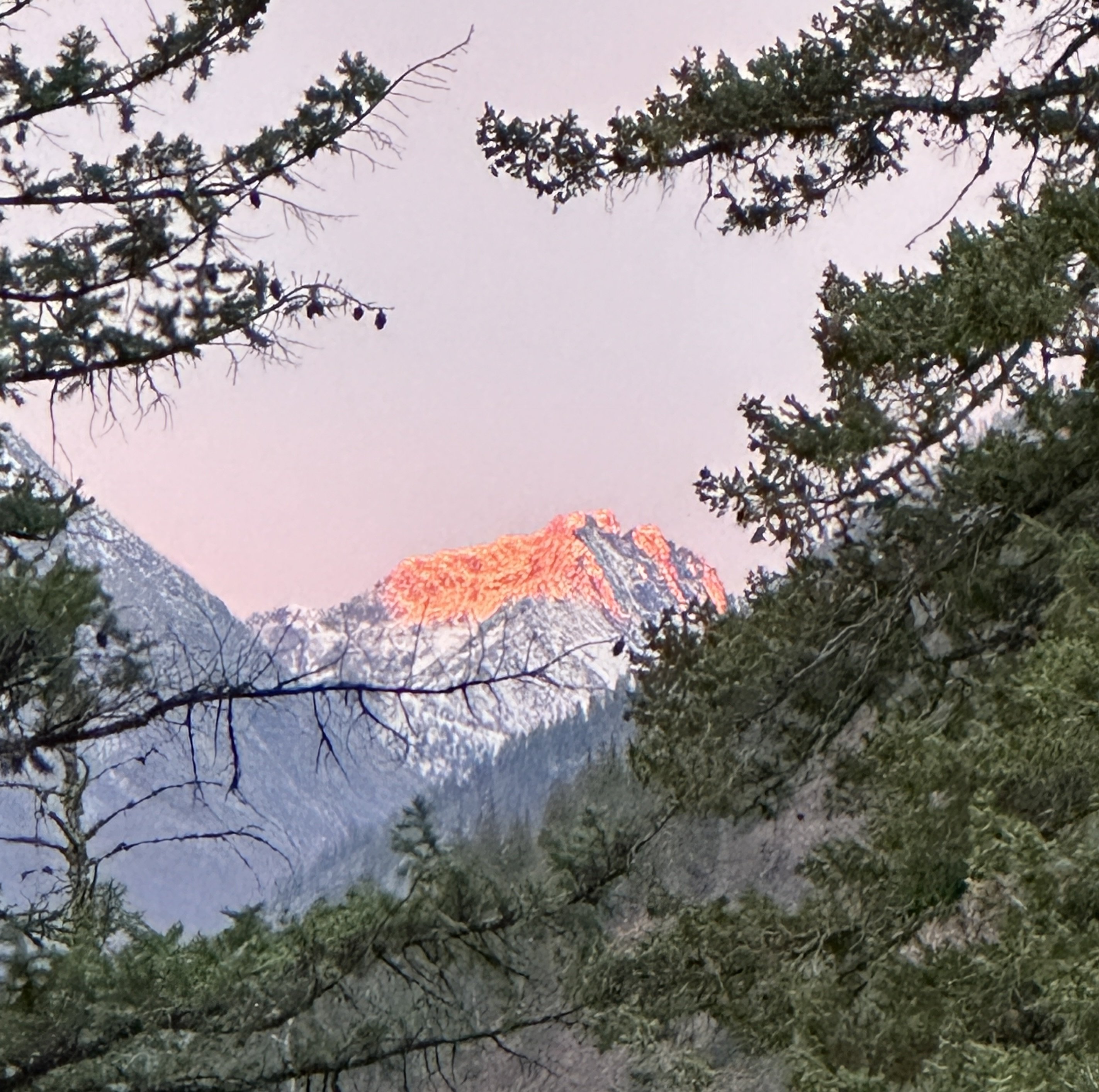-
Posts
3899 -
Joined
-
Last visited
-
Days Won
25
Content Type
Profiles
Forums
Events
Everything posted by Bronco
-
It worked surprisingly well for me at the Green Creek trailhead which is in a deep valley with lots of trees. This kind of sucks but it will result in less folks lost in the backcountry if they can message for help on their iPhone.
-
I was able to text with my wife on my iPhone from the Green Creek drainage near the Twin Sister range recently. Also sent and received one from the trailhead which is pretty heavily treed. I'm planning to cancel my inReach subscription based on the cost ($0 vs $17/month), performance and convenience. It sounds like the satellite system isn't quite as robust as Garmin's but probably adequate for my needs in North America. Anyone else used the satellite service on their iPhone?
-
-
-
"Might as well win the whole fucking thing!" Gave me chills watching Cal hit #60 to chants of "MVP! MVP!"
-
Only team in MLB to never have been to the World Series so, yeah.
-
I say fire everyone on the Mariners pitching staff.
-
Super discounted from $180 to $27 USD. Willing to work with the fixed leg loops. https://outlet.arcteryx.com/ca/en/shop/mens/skaha-harness
-
from here: https://www.climbing.com/culture-climbing/climbers-new-summit-peru/?utm_source=Mountain+Tactical+Institute&utm_campaign=fa2d4fb6fe-EMAIL_CAMPAIGN_2025_05_14_04_59_COPY_01&utm_medium=email&utm_term=0_-108b308039-274756150&mc_cid=fa2d4fb6fe&mc_eid=83876508f4 Last month, professional European alpinists Dani Arnold, Alexander Huber, and Simon Geitl climbed some outrageously beautiful new terrain on Jirishanca (6,125m), in Peru’s Cordillera Huayhuash range. Photos circulated soon after, showing the men jamming steep grey limestone, perched on exposed bivy ledges, and smiling on what looked to be a summit. But the most widely shared image was one taken directly below the mountain’s southeast aspect. In the photo, a bright red line traces a weakness in the steep rockwall before branching onto the East Ridge. The climbers proudly touted their effort as a new route: Kolibri (5.11d A2), which ended on the mountain’s “east summit.” The only problem? The east summit doesn’t exist. The stunning southeast side of Jirishanca with the line of Kolibri marked. Kolibri climbs sections of the route Suerte(also known as the Italian Route) and finishes on the East Ridge, which was first climbed in 1957. From this foreshortened angle, the “east summit” does indeed look prominent. But another, more honest angle (shared below) depicts this feature as merely a brief bump in an otherwise steep landscape. (Photo: Dani Arnold) Where is Jirishanca’s “east summit”? Climbing has, for better and worse, written extensively about Jirishanca over the last three years. In 2022, Americans Josh Wharton and Vince Anderson freed Suerte (5.13a WI 6 M7; 1,060m) during the same period that Canadians Quentin Roberts and Alik Berg established Reino Hongo (M7 AI 5+ 90° snow). Afterward, the Canadians accepted alpinism’s greatest formal honor: the Piolet d’Or. Two years later, Jirishanca became the backdrop of a great debate when Reel Rock made a film about Suerte—but photoshopped key moments out. So when I—who’d edited or written no fewer than four in-depth articles about the mountain—first saw the image of Jirishanca marked up with the supposed line of Kolibri, I was surprised I hadn’t heard of an “east summit” before. Wharton had climbed high on the same ridge in 2015 and 2019 before reaching the main summit. Had he ever considered stopping on this so-called sub-peak? When I connected with Wharton over email, he told me he was unaware of any “east summit.” “I actually reached [the Kolibri team’s] high point on my very first trip to Jirishanca in 2015, climbed well beyond it in 2019, and ultimately made the actual summit in 2022,” he told me. “What they are describing as a ‘summit’ is really just a flat spot in the ridge about six to eight pitches of non-trivial climbing from the actual summit.” Wharton explained that, compared to the relatively straightforward rock climbing that comprises the lower section of the mountain, Jirishanca’s steep, snow-choked summit ridge is actually the mountain’s crux “in terms of logistics, conditions, and tactics.” The summit ridge may not have a flashy mixed or rock grade, but it includes real, consequential fifth-class snow climbing. Dani Arnold stands in slings during a steep mixed pitch on Kolibri. (Photo: Dani Arnold) Wharton also said that, generally, he was not hyper-critical of those who end alpine routes below the summit. “I’m not a ‘summit guy’ when it comes to trivial snow fields, a five-foot summit boulder problem, or even three pitches of 5.8 atop a 15-pitch 5.13, for instance,” he said. However, for big, technical mountains like Jirishanca, he admits that, for him, “the true summit does count for something.” I then reached out to Quentin Roberts to ask if he’d heard of an “east summit.” He said no, and sent me a photo of Jirishanca from a more sobering perspective, circling the flat bump which constituted the Europeans’ “summit.” Jirishanca from the southwest. The red circle marks roughly where the Kolibri team labels the “east summit.” (Photo: Quentin Roberts) What were Arnold, Geitl, and Huber thinking? Thoroughly confused, slightly annoyed, but still hopeful some logical answer existed, I decided to ask Arnold to explain himself. Was he aware of other climbers who recognized the east summit? Was he at all interested in reaching the main summit? Over email, he said he was “not sure” about other parties ending their routes where he ended his, and acknowledged that the team’s ultimate goal was, indeed, to gain the main summit. When Arnold and his team breached the steep rock crux low on the mountain, they felt certain they would stand on top. But conditions would have it otherwise. “It turned out that the most challenging part was not where we thought it would be,” he explained, describing the upper slopes as having “extremely dangerous” snow conditions. “You can dig down a meter and still won’t find any holds.” During this email exchange with Arnold, any remaining benefit of the doubt I had dissipated. Arnold, Huber, and Geitl had retroactively lowered their definition of success midway through their climb. They wanted the main summit. They realized the main summit was too dangerous/difficult to attain. They looked around, noticed they were on a relatively flat piece of terrain, and decided their “route” ended on that “summit.” That doesn’t seem very sporting to me, and it sets a poor example to any aspiring alpinist who looks up to these professionals. The team poses on their summit, with the top of the mountain conveniently out of view. (Photo: Dani Arnold) What they should have been celebrating I was truly disappointed to realize these climbers had probably invented a new summit merely for the purposes of sharing an archetypal climbing success story. I’m not sure whether their decision was the result of inflated egos or the sponsor-induced pressures of being a modern-day professional alpinist. Regardless, it felt like there was an underlying sense of inadequacy at play. I thought back to something the American alpinist Colin Haley had written for Alpinist in 2016. He titled the Facebook series “No shame in failure.” “[…] Climbing to the very top of a mountain is always more difficult than climbing only partway to the top of a mountain. … More painful are the times that we badly want to reach the top of the mountain, but the various forces that make alpinism difficult turn us down below. However, just because we’ve failed does not mean we can’t be proud of our effort. … When I see climbers claiming success without reaching the top of the mountain, it makes me believe that there must be some sort of misplaced shame in an attempt. …” Haley went on to share anecdotes about the numerous near-miss successes of his career, including, most notably, Patagonia’s Torre Traverse (5.11 A1; 2,220m) in a single day with Alex Honnold—save for two straightforward pitches of rime-ice climbing. Haley didn’t pretend there was some new, previously unknown sub-summit two pitches below Cerro Torre’s real summit. He chalked the experience up to an attempt—itself among his best climbing accomplishments—and returned the next year to finish it up. In the high-stakes game of alpinism, the Jirishanca team’s approach feels like a fundamentally dangerous idea to promote: that “success” only happens if you reach a summit. Instead, I wish they were emphasizing their decision to prioritize safe, secure climbing over achieving their goal. After all, the summit wasn’t impossible, it was unexpectedly difficult. I want to celebrate this team for ending their attempt when the terrain exceeded their risk tolerance. I do not want to celebrate them for inventing a new summit because they felt obligated to share a textbook definition of success. That is not the spirit of alpinism.
-
Pretty great, the force is strong in this one.
-

[TR] Mount Index North Peak - North Face 06/29/2025
Bronco replied to Lucas Ng's topic in Alpine Lakes
The North Peak of Index is a proud outing. One of the difficult 10 if you didn't know and now you have first hand route details for going back for the full traverse. -
For clarification, it's my understanding they were climbing the glacier route on Silver Star and fell in the area of Chianti Spire. I'm a mountain rescue volunteer and don't have any problem with them requesting a rescue. Falls like that can cause internal injuries that may not be apparent. Live streaming the rescue is totally inappropriate and should result in a loss of phone privileges for a minimum of two weeks and no TV after dinner.
-
My takeaway is don't get complacent if you're not the team leader or you're just less experienced than your partners. Research the routes, know the descent and if you have concerns, speak up. I wonder what compelled this group to intentionally plan to descend the climbing route (the day before) instead of the standard descent that did have fixed anchors.
-

[TR] BULLEN! - via Squire Creek/Bullen Lakes 06/01/2025
Bronco replied to JasonG's topic in North Cascades
Great timing catching the avalanche! 👍 -

[TR] Austera & Klawatti - Scramble routes 05/24/2025
Bronco replied to Lucas Ng's topic in North Cascades
Awesome, thanks for posting! -

[TR] Gothic and Del Campo - Standard Routes 05/17/2025
Bronco replied to Lucas Ng's topic in North Cascades
Awesome, that's a good day in the alpine! -
Someone on FB linked this go fund me page for one of the climbers. RIP. https://www.spotfund.com/story/f2174a23-36a7-4434-bf55-853dce5d17af?fbclid=IwY2xjawKQmSxleHRuA2FlbQIxMQBicmlkETFxdHdMcjI4N3VEakpZSmN0AR6AS8Hodhucn9wrKe56lQ9ozehQodGwuPuueXkVs6vLvtpmpnYOnX38S1Ogfg_aem_wqvs2a2IOK7RronyZfN5sQ
-
Holy cow that was hilarious!
-
Hopefully some Washington Pass action once the snow melts a bit and plantar fasciitis/achilles tendonitis heals up.
-
More evidence that boomers ruin everything for the youngsters. How's this kid supposed to be the youngest to climb anything now?
-
Nice write up and Showa 282-02's for the win!
-
I wonder how this will affect NCNP permitting this summer. Self issue? No enforcement? Will it be overrun with social media content dorks? Might be a busy summer for SAR.
-
Nice, congrats on completion of the Difficult 10!
-
Congrats Jason!








